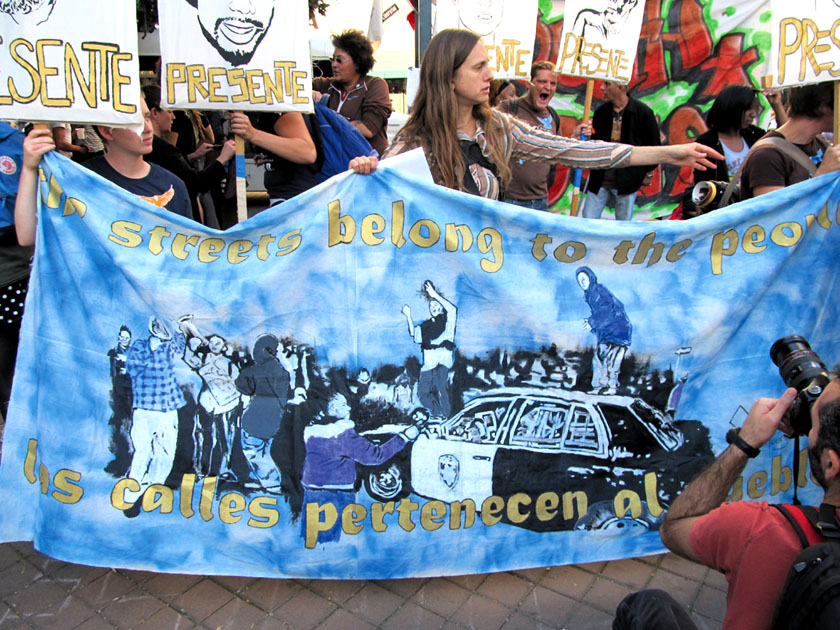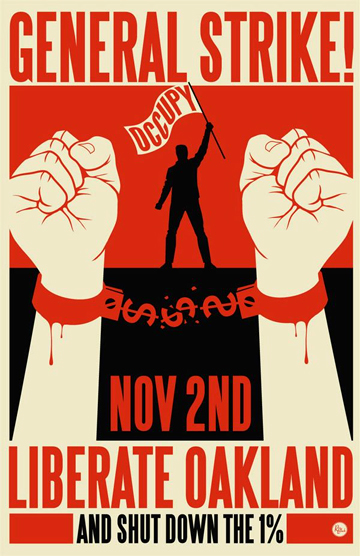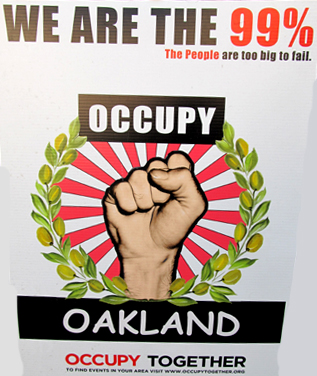
Editorial by Terry Messman
[dropcap]O[/dropcap]n Wednesday, November 2, I witnessed history being made as more than 10,000 people marched through Oakland in an extraordinary display of nonviolent resistance to a government and an economic system that has been rigged against the poor, and in favor of the rich.
Occupy Oakland sent out a call for a general strike, a seemingly utopian goal that would require the unswerving dedication and massive commitment of thousands of people. At first glance, it seemed nearly as impossible a proposal as Don Quixote battling the windmills. Yet against all the odds, they pulled off one of the most inspiring and successful nonviolent demonstrations in recent history.
Occupy Oakland galvanized countless thousands of people to occupy downtown Oakland, created a large tent city in the very shadow of City Hall, and marched through Oakland to shut down its major banks, and the Port of Oakland itself.
This virtually leaderless group of determined activists organized a huge march all the way from Oakland City Hall to the Port of Oakland several miles away, where protesters triumphed in shutting down the entire port, an amazing accomplishment that announced to the world that this movement was so bold and uncompromising as to challenge the global reach of transnational corporations.
‘The most powerful movement ever’
As we marched to shut down the Port of Oakland, a longtime friend of mine, David Hartsough, a co-founder of the Nonviolent Peaceforce and the director of Peaceworkers, told me that the march was perhaps the most powerful and hope-filled movement he had ever witnessed.
That is an extraordinary tribute to Occupy Oakland, given that Hartsough has been an activist for more than 50 years, and has been a key participant in the civil rights movement of the early 1960s, the antiwar movement in the Vietnam era, the huge anti-nuclear movement of the 1980s, and the Gulf War peace movement of the 1990s.
Those past movements preserved human rights, stopped wars, created social change, and are now enshrined in our history as a people. Hartsough witnessed all these movements at first hand and was arrested for civil disobedience while taking part in them. So it was nothing short of astonishing to hear him say that Occupy Oakland is the most powerful and promising movement he has ever seen.
In less than two months, the Occupy Wall Street and Occupy Oakland movements have unleashed an historic outpouring of people’s power that may well represent the best hope to radically transform our society we have seen in decades.
Activists began converging at Frank Ogawa Plaza on the morning of November 2 and were buoyed to see that City Hall — the very symbol of governmental power — had been taken over by occupiers and converted into a people’s encampment. More than 100 tents covered nearly every square inch of land in the plaza outside City Hall, and the entire area bristled with signs defiantly announcing the movement’s intent to shut down a system that has become a servant of Wall Street, the Pentagon, the banks and the global corporate elite.
A country run by the banks
All afternoon, marches were launched from the corner of 14th and Broadway to downtown Oakland’s business district. This country is basically run by the banks, and that was perhaps never made more clear than when the public was forced to hand over billions of tax dollars to bail out the same corrupt financial institutions that have foreclosed on countless thousands of homes, and have ransacked the U.S. economy like a den of thieves.
But in Oakland on November 2, the people were no longer the pawns of the banks. Instead, protesters shut down such widely discredited symbols of financial power and corruption as the Chase Bank, Wells Fargo and Bank of America.
Working without visible leadership, without offices and nearly without a budget, Occupy Oakland has succeeded in building a genuine populist uprising. It has mobilized the kind of nonviolent insurrection that Martin Luther King spent the last months of his life building. King envisioned a Poor People’s Campaign that would build a grass-roots rebellion all over the country and resist militarism, imperialism, racism and the corporate capitalism that forces millions into poverty. King and his dream of a massive uprising was assassinated in April 1968.
Many of us have long hoped for a rebirth of this vision. How amazing it is to see that this movement was reborn largely due to the work of young activists who were born decades after King’s death.
Or, to cite a closer historic parallel, Occupy Wall Street and Occupy Oakland have begun to build the kind of grass-roots revolt that fueled the Arab Spring and toppled one dictator after another. That accomplishment seemed beyond imagining until the first dictators were toppled. Now, in our own country, we are witnessing the first, hope-filled days of an “American Autumn” that has already begun to change history.
Distorted coverage by corporate media
U.S. activists have grown accustomed to the media’s biased coverage of social change movements, and the outright suppression of important stories. Three months ago, on Aug. 5, 2011, homeless activists from all over the West Coast held a massive march through San Francisco’s financial district to protest the union-busting Hyatt Hotel and financier Charles Schwab, and shut down Wells Fargo Bank. Yet, the corporate media avoided reporting on this undeniably newsworthy action organized by Western Regional Advocacy Project.
In the case of Occupy Wall Street, the mainstream media has been forced to cover these events, given the enormous number of occupations and the coast-to-coast extent of the protests. But too often, the corporate media have downplayed the significance of the protests, undercounted the numbers, and distorted the coverage.
On November 2, Occupy Oakland estimated that up to 30,000 people took part in protests at some part of the day, and more than 10,000 people peacefully marched in a successful effort to shut down the Port of Oakland. But the corporate press devoted a disproportionate amount of coverage to the acts of a handful of people who threw rocks at store windows and spray-painted graffiti. The media pounced on these few instances and breathlessly reported them as if unbelievably terrible crimes had been committed.
What is wrong with this picture?
First, the vast majority of demonstrators in Occupy Oakland have been deeply committed to nonviolence, even when facing extreme provocation by the police. The General Strike on November 2 was held in a city still dismayed at the violent raid by Oakland police on October 25 that ended in more than 100 people being arrested, tear-gassed and beaten by police. Flash grenades and tear gas canisters were shot indiscriminately at close range and many are still in shock over the life-threatening skull fracture sustained by Scott Olsen, an Iraq war veteran attacked by Oakland police.
Second, more than 99% of the people who marched on the Port of Oakland were nonviolent. Did they receive 99% of the news coverage for their principled and peaceful actions? No. Instead, the media gave coverage out of all proportion to the handful of people who did not adhere to nonviolence. The media always seems eager to sensationalize the acts of a few, no matter how small, whose actions might be used to give the movement a black eye.
Many demonstrators have become deeply distrustful of the media, and consider them to be an integral part of the system of corporate domination. At about 8 p.m. on November 2, many of us who were blockading the entrances to the Port of Oakland were overjoyed to hear that the longshoremen’s union had just promised that the port would be closed all night. It was heartening to see hundreds of young activists respond as they realized they had succeeded in shutting down the port.
Right then, a lone driver dangerously rammed his truck into a crowd of protesters on the road. Some were struck by the truck and everyone was appalled at the driver’s reckless actions. Many were angry. Yet, even in this volatile moment, nearly everyone exhibited great restraint and nonviolent discipline. Hundreds began chanting, “Peaceful! Peaceful!” over and over again.
The young people who had conducted themselves with such discipline, gentleness and restraint expressed great concern that the media would smear the movement if they even learned of this incident, even though the truck driver had instigated it.
Activists come to understand that in a demonstration when 10,000 people uphold the code of nonviolence, if even a handful of people ignore that code and do a few dollars worth of damage to a building, the media will cover it obsessively and blow it up out of all proportion to make it look like a major crime wave.
Yet, illegal acts of financial corruption by giant corporations may haul in millions or billions from outright theft, and receive less coverage. Catastrophic environmental crimes are committed by companies that endanger the lives of people, animals and the entire ecosystem, yet they usually do not receive anything close to the breathless coverage of a few people unwisely breaking a window or setting a fire in a dumpster.
Mainstream newspapers and TV stations often are owned by the same corporations that dominate the global economy. If you analyze the financial interests of the corporations involved in reporting on this movement, it is clear that their natural alliance is with Wall Street, and not Occupy Wall Street. All their economic interests, stock holdings and wealth make them loyal to the 1%, not the 99%.
The power of nonviolence
Activists should study the lessons of past movements and realize how powerful and transformative nonviolent resistance can be. Nonviolent resistance has been at the core of countless movements that have overthrown dictators, stopped human rights violations, won labor struggles, resisted wars and overcome segregation.
Far from being a weak or passive form of activism, Mohandas Gandhi said that nonviolent resistance enables a small group to “defy the whole might of an unjust empire.”
Yet, even as we call for nonviolence in our protests, we must also remember that Gandhi said poverty is the worst form of violence. The U.S. economic system is to blame for systemic injustices that have plunged millions of people into the hellish violence of poverty and homelessness.
In a country that spends hundreds of billions of dollars every year on cruel wars and senseless nuclear arsenals, we must not let the mainstream media detour us into thinking that graffiti and window-breaking are the worst dangers we face.
We need instead to pay attention to the dedicated activists of Occupy Oakland and realize that corporations have raided the economy, increased poverty and enriched the 1% at the expense of the 99%.

To visit the Occupy Oakland website click here.
